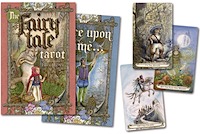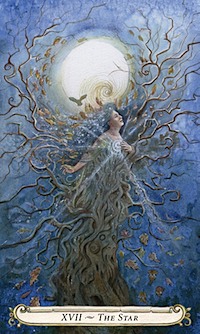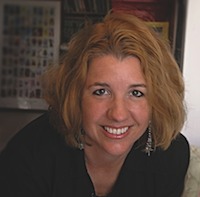By Melanie Marquis
“For me, there is something otherworldly about most tarot card images,” says Lisa Hunt. And Lisa’s own tarots are no exception. An empath with a passion for nature, this deck creator, writer, mom, gardener, and black belt martial artist takes us deep into the realm of fantasy and imagination through her art. As the author of Celestial Goddesses (Llewellyn Worldwide, 2001) and the illustrative talent behind D.J. Conway’s The Fantastical Creatures Tarot (U.S. Games Systems, Inc., 2007), the Celtic Dragon Tarot (Llewellyn Worldwide, 1999), and the Shapeshifter Tarot (Llewellyn Worldwide, 1998), Lisa is well-known for the mystical and heart-felt tone that dominates her work. Lisa’s first solo creation, The Animals Divine Tarot (Llewellyn Worldwide, 2004) was a smash hit, receiving great reviews and even winning a prestigious COVR award. So when we hear that Lisa is getting ready for the release of a brand new tarot deck, we know to expect great things. The Fairy Tale Tarot debuts this September from Llewellyn, so we coaxed this self-proclaimed studio hermit to step out from behind the drawing board to tell us more.
Tarot Reflections: Tell me how you got your start as an artist.
Lisa Hunt: I started pounding the pavement back in my late teens and had my start illustrating articles for a variety of periodicals. By the early 1990s, I was illustrating books for Llewellyn and doing work in the sci-fi/fantasy and children’s book industries. In between, I studied myths, wrote stories, taught art classes and started my journey as a tarot artist.
TR: What first sparked your interest in Tarot?
LH: My interest in tarot started in the late 1980s while exploring the works of Joseph Campbell and Carl Jung (The Archetypes and the Collective Unconscious changed my life). Jungian theory has been a major influence on my creative and divinatory explorations (I later studied Jung in Grad school). Sallie Nichols’ Jung and Tarot: An Archetypal Journey was certainly a pivotal book for me. I’ve been a dedicated student of tarot ever since ;)
TR: Your latest deck, The Fairy Tale Tarot, comes out this September from Llewellyn. I understand your passion for fairy tales started when you were a little girl. Are there certain stories you remember as your favorites?
LH: The first book I can remember holding is The Giant all-color Book of Fairy tales. It’s a well-loved worn and faded treasure. I think my favorite fairy tale depends on my illustrative influences during those impressionable years. But I tend to have an affinity for the selfless heroine who endures all manner of hardships without ever losing a sense of hope and optimism. The Wild Swans is probably one of my all-time traditional European favorites—it has all the elements I love in a fairy tale! But since immersing myself in fairy tale research, I have found less known gems hidden within the vast pool of world folklore; some included in my deck.
TR: How do you feel about the fear element in old fairy tales--you know, the idea of a monster to eat the bad kids and that sort of thing?
LH: Many of the stories in The Fairy Tale Tarot address this very issue. I think it’s important to be cognizant of the scary stuff contained in the fairy tale—to me, it’s part of what drives a good story and helps deliver important timeless messages. The monster in psychological terms is often the shadow: representing repressed feelings, our deepest fears and unresolved issues. And “monster as devourer” can also be seen as the vehicle/messenger for potential growth and renewal or a metaphor of unsavory human behavior (wicked stepmother, Bluebeard, etc.) By confronting “the monster” we’re in essence facing the shadow--in order to grow, expand and ultimately transform in positive ways, it is imperative that we recognize its presence and adjust ourselves accordingly.
TR: What personal significance does The Fairy Tale Tarot hold for you?
LH: To me, The Fairy Tale Tarot project was a dream come true. It marks a milestone for me personally and professionally. Llewellyn gave me the liberty to choose my own deadline, so I gave myself the luxury of years to thoroughly research stories from all over the world, write thoughtful prose and paint soulful watercolors. It was a delicious project from the start and I think represents a certain maturity and confidence that reflects many years of passionate labors.
TR: Tell me more about these labors—how do you go about creating tarot images, anyway?
LH: Everything starts with a sketch. I have 4-5 little sketchbooks filled with fairy tale doodles. The initial drawings help to release the ideas. Once I settle on a sketch that feels right, then I will create a finished tracing of the drawing and transfer it to watercolor paper. I’m very old fashioned in that way! But it works and I very rarely have a “failure” once a concept reaches the painting stage.
TR: Do you ever find the artistic process challenging?
LH: I thrive on challenge and am never afraid to jump into an idea and see it to fruition. If a concept is meant to breathe life, it will. I think my biggest problem is the inability for my corporeal reality to keep up with my unquenchable need to create (I’ve been this way since I was a child). It’s hard to admit fatigue and be forced to call it a night when there are so many ideas to explore. This is where martial arts kicks in—as my TKD master recently told me: “The soul has no limitations other than the body that houses it.” So the real challenge for me is to maintain balance between body, mind and soul. I think that is my key for continual creativity.
TR: What do you feel is the power, the function of tarot art?
LH: For me, there is something otherworldly about most tarot card images--I believe they have the potential to break down barriers between the conscious and unconscious, thus allowing one to access all kinds of information residing in the psyche. That is one reason why I've always been fastidious about the inclusion of detailed symbolism in all of my artwork. I think the provision of symbols can serve as a bridge between different channels of the mind. I find it an endlessly fascinating and inexhaustible medium full of mysterious beauty.



